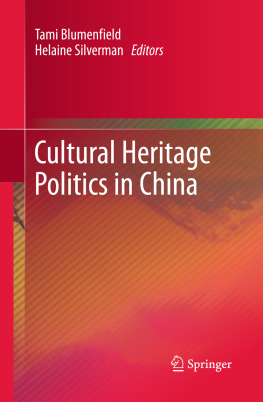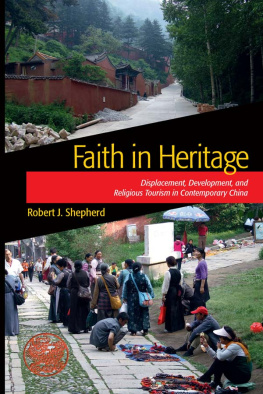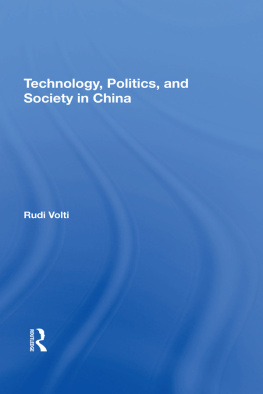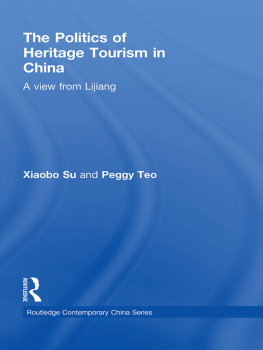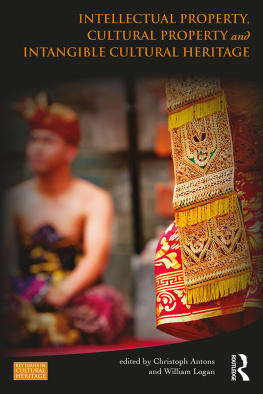Introduction
In 1966, the Peoples Republic of China embarked on a campaign to eradicate the Four Olds: 369).
Marking over 20 years of an entirely different approach to cultural heritage, China began celebrating Cultural Heritage Day in 2006. Instead of exhorting urban youth to burn books and damage relics, the new ideology officially encourages preservation of historically valuable sites and objects. At the same time, Chinas rapid economic transformation and real estate frenzies beginning in the 1990s have made urban demolition a regular sight nationwide and dam construction and other water projects routinely submerge spaces of historical significance. What accounts for these dramatic shifts in a relatively short time period, and how can the contradictions of simultaneously destroying and protecting heritage be understood? Broadly speaking, how universally embraced is the current rhetoric about heritage preservation? And what, if anything, is particular about the role cultural heritage plays in this nation of nearly 1.35 billion people?
A consideration of cultural heritage politics in China implicates tourism, economic development, government ideology, national and ethnic imaginaries, social sustainability, and intraregional, interregional and international relationships within the framework of Chinas fast-paced modernization in the context of globalization and Chinas assertive political maneuvering on the world stage. In 2010 China convened an international conference to consider cultural heritage values, threats to cultural sites, and the involvement of local stakeholders in site protection (Yu et al. ).
Analysis of recent Chinese leadership attitudes toward cultural tradition reveals an official intent to enlist it as a constructive factor in unifying the Chinese nation Chinas cultural tradition has become a strong bond for ethnic harmony and national unity (Ai : 7). Heritage in China generates a range of contradictions, such as praise for Tibetan civilization but not Tibetan society and promotion of the Imperial Palace of Beijing as a prime tourist destination while selectively representing the regimes that produced it.
In addition to its World Heritage List sites, thousands of other cultural sites in China are key cultural relics protection units (Shepherd : 68). Given these incentives, government officials in charge of heritage preservation may be less powerful than officials who authorize sales that require destroying built heritage.
Without the threat of censure from an intergovernmental organization, little inhibits destruction of wide swaths of historically significant buildings and even mountain landscapes. The obliteration of most of Beijings hutong , or courtyard lane residences, is but one highly visible example.).
In sites that escape demolition, structural bifurcation exists between heritage offices and tourism offices that usually contract with private tourism companies to develop infrastructure and manage sites. This is a manifestation of the broader privatization that encompasses much of todays China (Ong and Zhang disregard for regulations may hold long-term and irreparable consequences. Egregious damage to a cultural heritage site may engender public outrage, but violations rarely result in significant penalties beyond rebukes.
China, UNESCO, and Cultural Heritage Bureaucracy
Following a somewhat delayed engagement with the global cultural governance regime of UNESCO, China ratified the 1972 World Heritage Convention in 1985. The next year, China proposed its first five cultural sites for inscription, which was achieved in 1987. As a result of extensive diplomatic effortsand the careful restoration and reconstruction of structures damaged in the late 1960sChina is now home to 43 UNESCO cultural, natural, and mixed World Heritage sites ( : 173).
Today, Chinas World Heritage properties include important pre-imperial and imperial sites such as Late Shang Dynasty Yin Xu, the Forbidden Citys imperial palace of the Ming and Qing dynasties, the Temple of Heaven and the Summer Palace in Beijing, the Mausoleum of the first Qin emperor and the famous Terra Cotta Army near Xian, the Mountain Resort and its Outlying Temples in Chengde, and the Great Wall. Major non-imperial cultural sites include Confucius home town of Qufu and the classical gardens of Suzhou as well as towns with notable vernacular architectureXidi and Hongcun in southern Anhui, the tulou of Fujian, Kaipings diaolou (multi-story defensive village-houses), Lijiang, and Pingyao. Religious sites are also on the World Heritage List including the Mogao Caves at Dunhuang, the ancient building complex in the Wudang Mountains, Mount Emei and the Leshan Giant Buddha, Dazu Rock Carvings, Longmen and Yungang Grottoes and Tibets Potala Palace (the latter being a highly contested site).
Chinas enthusiasm for the World Heritage List reveals three aspects of cultural policy. First, China has been employing a national strategy of cultural soft power on the global stage (see, e.g., Fiskesj : 255).
In the same way that western states have surveyedliterally and ideologicallytheir territories for the purpose of governance (e.g., Edney : 7273).
Chinas tangible cultural heritage is under a hierarchical and centralized state administration. However, increasingly, local governments are seeking to set their own standards and priorities for the best interests of the region, thereby engendering bureaucratic problems (Chen Shen and Hong Chen : 75). The principal problem for Chinas tangible cultural heritage is economic development, whose effects can be devastating on the valued physical environment and problematical for the in situ social one.
Chinas eager participation in the international system is not restricted to the tangible. China is a signatory to UNESCOs 2003 Convention for the Safeguarding of the Intangible Cultural Heritage ( ICHC ). A 2005 article observed that upon signing the ICHC China earmarked 46 million yuan (US$ 5.6 million) for a special project designed to preserve important cultural forms (Wang ), one form already on UNESCOs ICH list.

